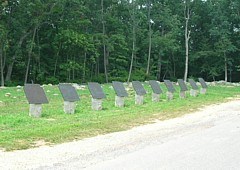|
One of the most important purposes of Gettysburg National Military Park is to preserve the topographic, landscape, and cultural features that were significant to the outcome of the Battle of Gettysburg. However, many of those features have been obscured or changed over the years, as natural processes have been allowed to take over. As just one example, fields that have not been farmed over the past 65 years have become forests. In many cases, the lack of an accurate understanding of these historic topographic features and their significance has led to their loss. That loss, in turn, meant that neither visitors nor historians could fully understand the Battle of Gettysburg.
The National Park Service (NPS) is bringing back missing features that affected the fighting of the Battle of Gettysburg, a multi-year project with historical benefits and environmental benefits as well. The goals of the project are:
Restoring Gettysburg’s historic integrity -Changes to the landscapes have occurred over time including the growth of trees, changing field sizes, and missing fences, orchards, and farm lanes. These changes obscure the key terrain, avenues of approach, and fields of fire that affected the outcome of the battle. As a result, some portions of the battlefield have changed physically. They can no longer convey to people today what it was like for the soldiers who fought there.
The project is being phased and includes the replacement of historic fencelines, orchards, and farm lanes as well as the return of grasslands, farmlands, orchards and woodlands that played important roles in the battle.
Enhancing visitor opportunities and understanding - Restoring the integrity of key battle areas contributes to improved educational experiences, and an overall greater understanding of the events as they unfolded on July 1, 2, and 3, 1863. Battlefield rehabilitation is allowing visitors to have a more accurate understanding of obstacles faced by those on the field as well as the command decisions made by both armies. Over time, the project will offer new opportunities for visitors to see the battlefield through the soldiers’ eyes.
Creating a sustainable historic environment by improving wetlands, water quality and wildlife habitat – Since the time of the battle, non-native species, hardwood stands, and changing agricultural landscapes have had a negative effect on the historic terrain. If left alone, the environment will continue to change and potentially obscure more historic lands.
By reestablishing grasslands, restoring wetlands, replanting orchards, and removing non-historic trees the NPS can rehabilitate the historic assets of the battlefield. Use of phased rehabilitation plans and long-term maintenance plans is improving the sustainability of the environment.
Long term improvements to the environment include: restoration of wetlands; fencing cattle from streams to improve water quality; and increasing habitat for grassland species, ground nesting birds and native plants.

(National Park Service) 
(National Park Service) During the early years of park management, selected commemorative elements were removed from the battlefield landscape for purposes of traffic flow and safety for park visitors. In recent years, the National Park Service realized the necessity for replacing these historic elements in the park and based on the 1999 General Management Plan, many of the signs and tablets removed during the 1930's and 1940's have since been restored to the park tour route. The most recent project was the rehabilitation and placement of the Itinerary Tablets for the "Army of Northern Virginia", completed in the summer of 2006. The tablets for the "Army of the Potomac" will also be replaced on the battlefield landscape within a few years. |
Last updated: February 26, 2015
